How to connect the hob to a single-phase and three-phase network
When buying new equipment, few people look at the power requirements, but in vain. In old houses, when installing powerful equipment, there are problems: it may be necessary to pull a separate line. So, connecting the hob to maintain the warranty requires compliance with all the requirements of the PUE. This means that you need a dedicated line with an appropriate wire cross-section, with a circuit breaker installed on the line. This line can end with a special socket or maybe a terminal box. If a socket is installed, then the cable from the hob must end with a power plug, when installing the terminal box, the ends of the wires are terminated with clamps, you can tin them and roll them into a ring.
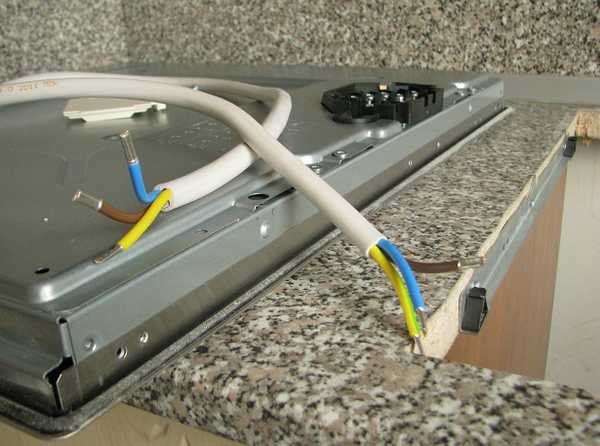
We figure out how to connect the hob
The content of the article
Hob connection diagrams
Almost all new models of European-made hobs can be connected to networks with a different number of phases. In our country, there are two standards: a single-phase 220 V network and a three-phase 380 V. In some houses, 220 V comes with two phases. If we talk about the number and colors of wires, then this is what can be:
- Single-phase 220 V.
- Two conductors. Found in old houses. In this case, the wires are usually the same color. You can find the phase using a probe (screwdriver with LED) or a tester. It's easier to work with the probe: if the LED lights up when the probe touches the live part, this is a phase, if not, it is neutral (zero).
- Three wires. Most often, the wires are colored. Red or brown is the phase, blue or cyan is zero (neutral), yellow-green is ground. If the wires are the same, the phase one is located with a probe, and to determine the neutral, you will have to look for a multimeter or tester.
- 220 V network with two phases. This is already exclusively in new buildings, but it is not common. The phase wires in this case are black and brown, the neutral, as usual, is blue and the ground is yellow-green.
- Three-phase connection 380 V. If the colors are observed, the neutral and earth are of the usual color, and the phases are yellow-red-green or, according to another standard, white-black-brown.
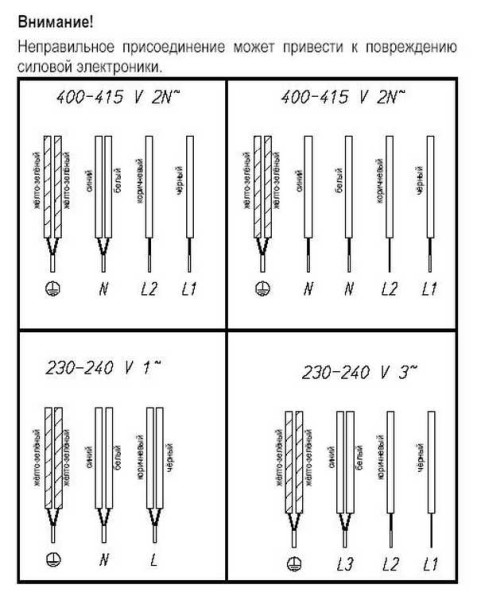
Connection options for one of the models
In order not to be mistaken, even if you see all the named colors, it is better to check everything (call): builders often get confused during installation. To avoid trouble, check and sign (hang tags).
The peculiarity of hobs is that they often come without a power cord. This is not due to the greed of manufacturers, but because they can be connected according to several schemes, in which from three (we have - from two) to six wires are used. Therefore, in addition to the wire for connecting to the electricity meter, you also need to buy a network cable. You take it of the same section as in the lead one, only it is more convenient to use multi-core - they bend well.
How to connect wires in a junction box read here.
Connection to a single-phase network
Most of the questions arise if you need to connect an electric hob to a 220 V network. Most often, the panel has 6 terminals: three phase - L1, L2, L3, two neutrals (zero) N1 and N2 and PE grounding, and in the apartment there are only three or even two wires (in old houses). It's not scary - you need to install jumpers, but first we look for where the terminals are located on the hob.
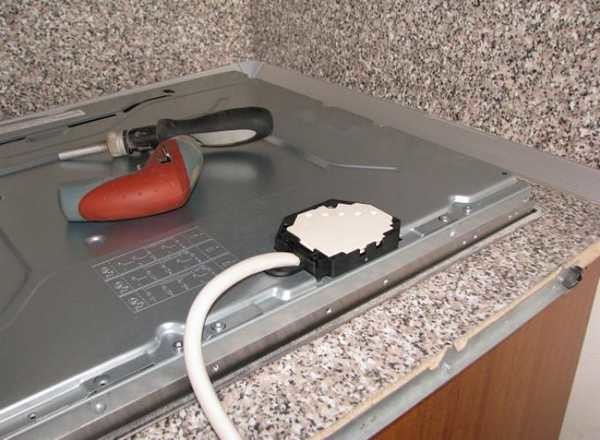
A small socket with leads can protrude above the surface, or it can be recessed
To get to the wires, we find a small cover on the back. It can be metal or plastic, it is fixed to the case with screws or snaps into place. We remove it. Inside there is a six-pin terminal block. If there are three wires in the apartment, the contacts are connected on the hob:
- three phase wires together (L1, L2, L3);
- two neutrals N1 and N2;
- The ground (green) wire connects to ground.
If the equipment was bought in a store, it should come with jumpers installed, which connect all the indicated wires. In this case, the wires of the power cord are connected to each group of contacts: one to the phase, one to the neutral, and yellow-green to the ground.
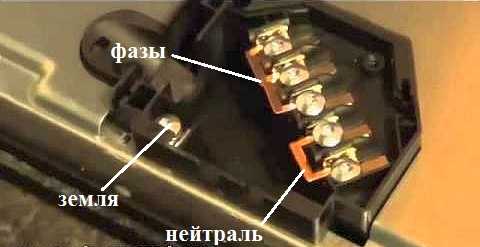
Connecting the hob to the mains: this is how the jumpers should be for a single-phase 220 V network
If the jumpers are lost somewhere, you can make them from a copper wire with a cross section of 6 mm2... To make it more convenient to connect, use tips - fork or ring, whichever is more convenient for anyone. It is more convenient to clamp stranded wires in them, and it is easier to bend rings from one core.
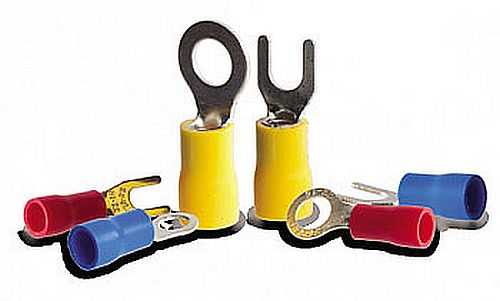
Copper insulated lugs
With three wires in a 220 V network, the hob connection will look like in the photo below. Please note: the "ground" wire is connected to the upper contact of the socket, the phase can be on the right or left - not so important, but the wires in the socket must be routed in the same way. You can't be wrong.
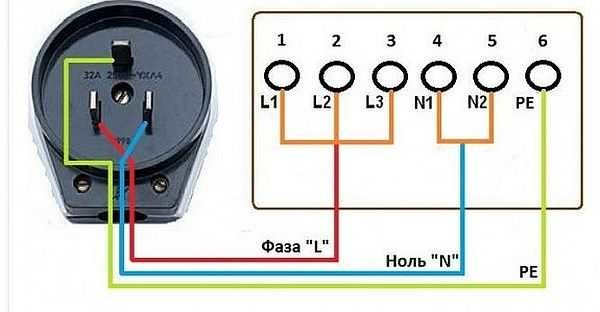
Connection diagram of the hob to a single-phase network
If there are only two wires from the meter, you can do it in two ways:
- make a separate ground loop
- Do not use the "earthen" outlet at all.
Installation of a ground loop is necessary if you want to preserve the warranty: when connected without grounding, it is invalid and in case of any damage to the hob (even an obvious factory defect), you will be denied warranty repair or replacement of equipment with a serviceable one.
How to connect the hob 4 wires
Many Electrolux and Zanussi models come with an installed cord. It seems to be good, but it has four wires: zero, ground and two phase wires (black and brown). If there are three of them in the apartment, it is not clear what and what to do: connecting a four-core wire from the hob has its own nuances.
In this case, you also get to the location of the terminals on the back of the case. The lid in such models is plastic, and not on bolts, but on clips. Just pry it off with a screwdriver.
After opening the box, look for the exit "ground" (yellow-green). There is a jumper for two entrances near it. Take it and combine two phase outputs - L1 and L2 (black and brown conductors are connected). Just loosening the contacts a little (by turning the screws with a screwdriver), slip the jumper, then tighten the contacts. Everything else is unchanged. In the future, when connecting the plug, use only the brown wire, and insulate the black wire well (better with a heat shrink tube).
How to connect an RJ-45 Internet socket and crimp the connector, read here.
Connecting the hob to a 380 V three-phase network
To connect the hob to a 3-phase network, a cable of five copper conductors with a cross section of 2.5 mm is required2... Single or stranded - optional.
In this case, a jumper is needed only on two neutral wires - N1 and N2 (in some models there is only a digital designation, 4 and 5 outputs are combined there). There is no need to change anything on the phase wires: one of the phase wires is connected to each phase.
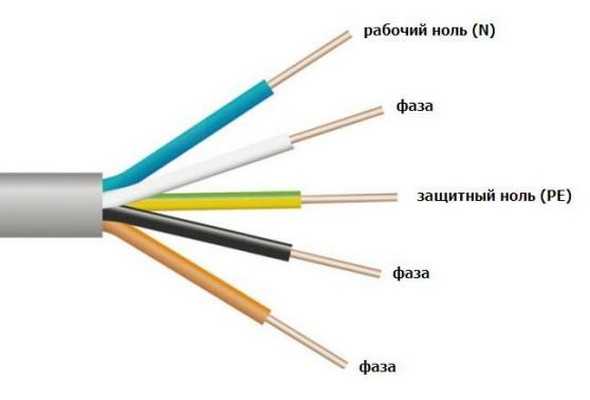
Cable for connecting the hob to a three-phase network
The cable may have the same color as in the photo, or it may be different. According to the second standard, the phases have colors: red, yellow, green. It's not that important. It is much more important to correctly connect all the wires to the plug, and also not to confuse them on the outlet.
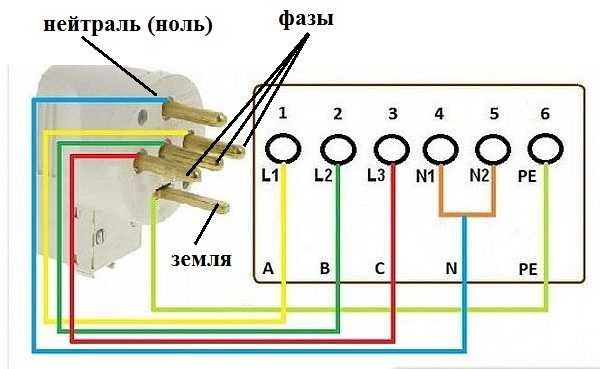
How to connect a plug to a 380 V hob
Please note that in this case, the neutral is connected at the top, the ground is at the bottom, and the phase wires are in the middle. The same procedure should be repeated for the outlet.
If a 4-conductor cord comes from the equipment, one of the phases on the plug is simply not used. What - all the same, just do not use the same output in the outlet.
220V with two phases
If there are four wires in the apartment and from the panel, everything is simple. Connect the corresponding colors. There are usually no discrepancies: phases are black and brown, zero is blue, earth is yellow-green.Difficulties arise if there are six outputs or the cord comes with five wires.
As you probably guessed, two phases are combined. The union of the two neutrals (if any) remains in force. Everything else is connected to the corresponding pins of the plug.
The location is the same: neutral at the top, ground at the bottom, in the middle of the phase. Do not forget which of the phase outputs you have is empty, so as not to redo.
Choice of cable and machines
As you already understood, you will have to lay a separate line from the shield to the hob. Most likely, you will be laying it secretly, in a box, corrugated hose or strobe. In this case, it is allowed to use only copper cable:
- for a single-phase network with an electrical power of 5.5 kW to 7.7 kW cable with a conductor cross section of 6 mm2 (VVG 3 * 6 or PVA 3 * 6);
- for three-phase up to 16.4 kW, 5 * 2.5 mm is enough2 (KuVV 5 * 2.5 or KuGVV 5 * 2.5);
After leaving the counter, you must install the machine. This requirement is mandatory. There are also recommendations - to install an RCD (residual current device) to protect equipment and ensure proper safety. Such a bundle allows you to turn off the power not only in case of overload (the machine is triggered), but also in case of problems with insulation (the RCD is triggered). RCDs are not the cheapest thing, but the hob is incomparably more expensive, so it's better not to save.
About the parameters of this equipment:
- for a single-phase network, we take a 32 A machine, a 40 A RCD with a differential shutdown current of 30 mA.
- for a three-phase one - a 16 A circuit breaker and a 25 A RCD with a differential trip current of 30 mA.
They are connected to each other with segments of wires of the same section (diagram in the photo above): in a 220 V network, 6 mm2, in a network of 380 V 2.5 mm2.
Read about assembling an electrical panel with your own hands here.
Socket and plug
The hob must be connected using power outlets and plugs or a terminal box. Power sockets and plugs are designed for currents exceeding 10 A, are made of special plastic, and may have a cover. The selection rule is simple: their rated current should be no less than the machine's current. That is, to connect an electrical appliance up to 7.7 kW to a single-phase network, we take 32 A, for a three-phase one - 16 A.
There is no single standard, so the shape and position of the pins can be different, it is important that the required number of contacts and the electrical characteristics are consistent. It's clear: it's better to trust trusted brands, not Chinese products.
You can connect the cable from the device and the power supply in the terminal box. This method is also called a plugless connection, "direct" or "direct". It is more reliable, but to turn off the stove you will have to go to the electrical panel and turn it off with a switch on the RCD or machine.
For a three-phase connection, it is better to use a Schneider Electric 102x100x37 IP44 40A (KLK-5S) box. It is not cheap, but reliable and looks decent: you don't have to hide it. It can also be used for a 220 V network - a wire with a cross section of 6 mm2 into the terminals will become and the extra phases will simply be empty. To connect, wires are inserted into the holes on the side, and they are tightened with bolts, the caps of which are visible in the photo.
As you can see, at the top there are three pairs of contacts for connecting phases (1,2,3). Below is for earth and neutral. On the one hand, a power cable is started, on the other, from an electrical device.
If you wish, you can save money and buy a simple block, but with good quality contacts and a separate mounting box with a cover.
The wires in such terminal blocks are connected simply: rings are formed from the stripped end of the copper wire (as in the photo above), into which small screws are inserted with plates put on them. The wire is inserted into the socket, the contact is tightened with a screwdriver.
If the wire is stranded, it is problematic to make a ring from it. Then you can use the tips (photo at the beginning of the article). They are crimped with pliers (can be replaced with pliers).
These are all the highlights. Now, connecting the hob yourself will not be a problem.The same rules apply when connecting other equipment of the same power. For less powerful ones, it will only be necessary to take a smaller cross-section of conductors and a lower rating of the machines.

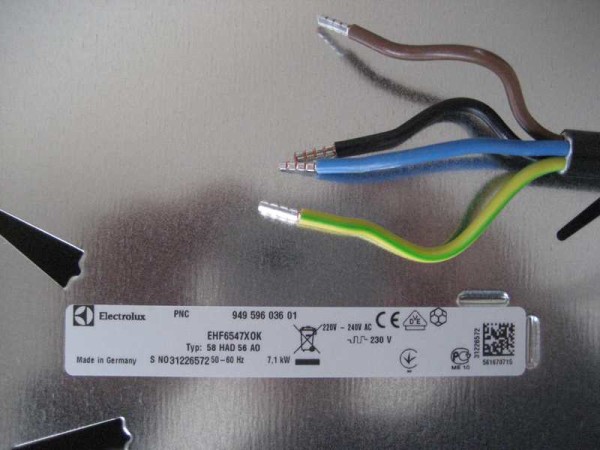
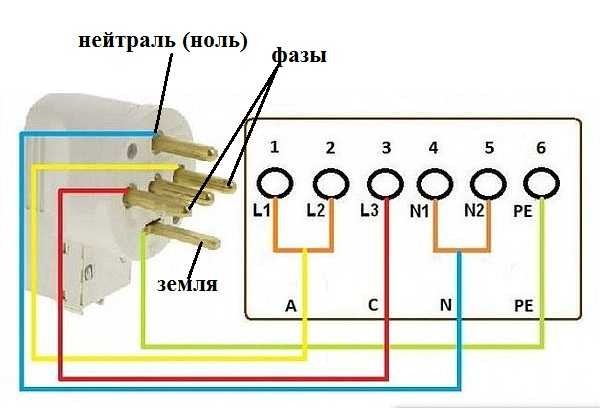
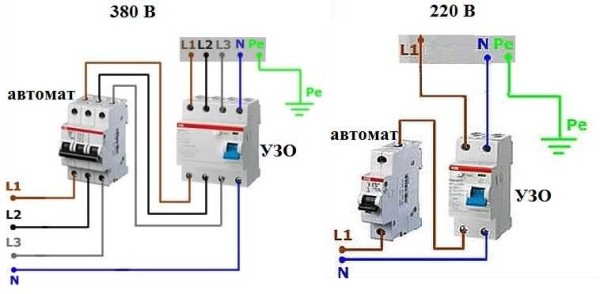
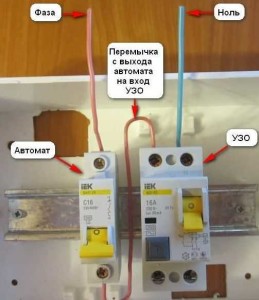
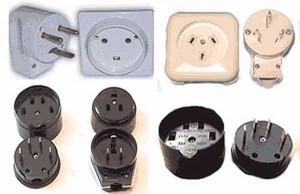

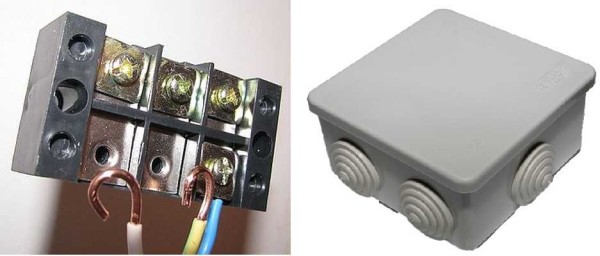
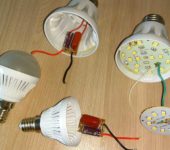
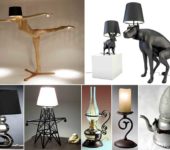
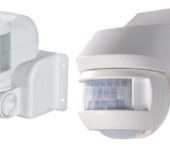
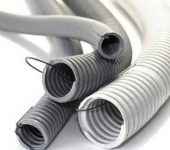
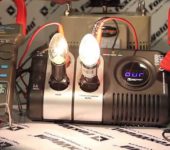





It is interesting what you do: in the article you write "for a single-phase network we take an automatic machine for 32 A, an RCD for 40 A ...",
at the same time attach a photo to the article, which shows that to protect the cable in a single-phase 220V network, you use a 16A machine and a 16A RCD.
Sometimes they do this, but it is better to take the RCD one step higher - there will be fewer false positives.
They went crazy with these RCDs, they hover it where necessary and not necessary, soon they will sculpt it in front of each switch, anyhow the object will rise in price
Explain, please: in the case when the hob has a 4-core wire, and the network in the house is single-phase. Why connect the black wire at all and then insulate it? It is possible, by connecting L1 and L2 with a jumper, the black wire
to disconnect and connect only through brown?
It is necessary to combine the phase inputs, because the equipment is made for two phases and it is not clear how it will work when voltage is applied to only one of them. At the input block, these phases are combined and work further in parallel. And when connecting the plug, we insulate the black so that extraneous voltage does not accidentally fall on this contact. It is rather a reinsure, but in an electrician it is better to reinsure a hundred times.
Isn't it easier not to bother with a jumper, but just connect black and brown to one contact in the plug itself?
On the diagram for connecting a hob for 220 volts, an RCD starts from the beginning, then an automatic machine, and on the photo, vice versa. Decide from the beginning how, subtract the material and check for the absence of "jambs". Electricity ...
The order of installation of the RCD and the machine does not affect their functions in any way
Affects. From the beginning there should be an automatic machine then then an RCD if there is a breakdown of the insulation and a person even touches the frame at the hob so that it does not hit the current, the RCD is turned off and the machine is only disconnected from overload or short circuit, but the RCD MUST BE GOOD EARTHED. without land, it will quickly fail itself checked 700 r. Threw away. Electrician 6 grade assembling electrical cabinets
Thank you.
The order does not affect the work. If the first is the RCD, all processes will proceed as you described (the speed of propagation of the leakage current or short circuit tends to the speed of light, and the response time of the devices is about 20ms). The only difference is in the convenience of wiring on the shield. Leading design engineer.
Hello. Maybe I'll find the answer to my question here. Electrolux induction panel. Everything is connected, as they say, according to Feng Shui. But when there is a metal dish (kettle, saucepan) on the surface of the panel, and if you touch this dish with your hand, it “butts”. The surface is turned off. That is, a very weak current is felt. If the indicator screwdriver touches the dishes, the light on the indicator lights up. If you take the panel out of the tabletop and touch the bottom, where the metal case of the panel is, then there is nothing. And the indicator on the screwdriver does not turn on, and the current is not felt by the hand. That is, the current flows through the glass-ceramic (the working surface of the panel).What to do, where to dig? Or direct access to the service.
The panel is working. Does not give errors.
I will say a BIG thank you if anyone responds).
Most of all, it looks like they messed up during assembly. For prevention, you can see if the grounding is normal. If everything is fine with him, and the panel is under warranty, we will go to service. At least call for a start.
Thank you. The panel has been out of warranty for a long time. I called the service, all for money. They said nothing. Visit or call the master.
Did you get it at the factory?
Grounding is ok. 2 sockets nearby. One for the oven, the second for the panel. The oven does not “butt”. I poke the forks in places, nothing changes. The oven is OK, the panel is butting.
To the service? Which one do you recommend?
How long has she been “butting” with you? Maybe somewhere there is a breakdown to the case? You can try ringing all the wires to the case. It's not difficult, but you will have to pay for the call. And it's better to ask your friends for recommendations.
"Butting" for a long time already. How to try ringing all the wires to the case? Provided that I am almost a complete zero in electrics. And there are no familiar electricians nearby ((.
Here I was answered from Electrolux below
Alexey, Good afternoon!
This is normal. The work is based on the principle of electromagnetic induction.
Best regards, Mikheeva Lyudmila
Specialist of the post-trade support department
LLC "Electrolux Rus"
But have you noticed this before? In principle, there may be interference, but not so great that it can be felt directly. And you have them, apparently considerable.
Ring the body ... take a tester or multimeter, set the switch to dial, touch the wire with one probe, and touch the body with the second. If the insulation is not broken, there should be no reaction. An article about measurements with a tester here.
Thank you. I will comprehend the basics.
No, not big. Someone does not even feel them.
If small, then it really can be induced currents. But still ring the wires. Away from sin.
OK. Thank you.
Thank you very much!!!! for a consultation.
You are welcome))
When connecting in two phases, can I use 2.5 sq. Mm wires?
Please tell me a panel with a capacity of 7.5 kW. 220 in. The wire is supplied with a copper conductor cross-section of 2mm. Automatic machine for 30 A. Can the wiring withstand this voltage?
Minimum 4mm and automatic 25A
Help with advice.
There is a var panel induction Electrolux. 4 wires come out of it, the socket is 1-phase. As I understand it, you need to connect as described in your article "How to connect a hob 4 wires".
Explain, please (I'm not particularly strong in an electrician, but with a well-described circuit I can connect):
- is it possible, without installing a jumper between L1 and L2, to put the black and brown wire on one terminal in the socket; - or by installing a jumper between L1 and L2, put the black and brown wires on one terminal in the socket.
Maybe I don't understand correctly, but it seems to me that from the point of view of physics, 1 wire per 2 squares can be replaced with 2 wires per 1 square. If this is true, then both described connection options look logical.
Thanks in advance for your reply.
You can also connect as you said. Both options. But to put two rather big wires on the same terminal in the plug, at the same time to achieve good contact, not to short-circuit with other wires located nearby - it's not very easy. But probably. Described is simply the easiest option to implement.
Hello, tell me, after the repair, I left a long wire from the wall 3 * 6 and 3 * 4, the question is whether it is possible to connect the hob and oven with these wires directly without sockets, pads, etc.
Hello! Do you mean screw your wire to the socket on the back of the stove / oven? If yes, then you can. It even improves reliability - the fewer connections the better. This is only possible, provided that there is an automatic machine on each line - to de-energize in case of damage or the need for repair.
Good day everyone.
I'm trying to figure out how to connect a Bosch hob. The panel consumes 7.5 kW. The workers laid a 3x4 wire with a separate machine. Single-phase 220 network. Can this panel be connected to a 3x4 wire? Is it possible to fall in love with the same wire in a 3.5 kW oven?
If you pull a separate 3x6 line under the hob, is it enough to put only a 32A difavtomat?
I have a 5-core wire with the panel. What is the best way to connect them: use only three wires, or is it better to throw two wires per phase and zero, and throw one to the ground?
One wire is enough. Insulate the excess.
Good day, please help. The electricians brought me a 4-core 2-phase 380 cable, as they told me. I have an electrolux, the power goes to it, but the coils do not work, I thought it was a marriage. I exchanged it for a new one, the same situation, the power is on, the right combs of the induction panel show as if there were no dishes, and the left ones even without dishes are heating, but there is no heating. the coils do not work. socket with two phases, wires from plate 4, can I combine brown and black and connect to one phase?
It's strange. Either phase 1, or 3 ... They could, of course, withdraw two, but this is, at least, strange. And check the number of phases yourself. And then you never know what they wound up there ... You either need a multimeter (read how to measure it here), or a tester screwdriver. If you don't have a multimeter, buy a screwdriver. It costs little, but a necessary thing in the household. If its probe is applied to the phase, the LED lights up (in some you must also press the button). A 220 V socket must have one phase (LED is on) and one neutral (off). If there are really two phases (the LED is on when you touch the two inputs of the outlet) and they are both brought out to the outlet (I doubt, of course) you need to reconnect the cable in the shield.
About the cord from the stove. There should be a plate on the back wall with possible connections. It can be paper or embossed on metal. If you need a 220V circuit, find it and see where and what to connect. In theory, the black and brown wires can be combined by placing them on the contact in the plug that goes to the phase in the outlet. But it is better to put a jumper on the plate outlet block. In this case, the jumper connects the contacts to which the black and brown wires are connected, which are essentially the same thing. They just write in the instructions.
If it is not clear, write ...
so it is understandable) thanks) but I have a private house and I think that they have brought 380 (380 enters the house) and I'm afraid to climb into this outlet with a screwdriver. electricians advised me to discard one phase in the shield and connect with a jumper on the stove. I will try to find the phase in the dashboard using an indicator screwdriver and put a terminal
Hello! Can you tell me which induction hobs are suitable for three-phase connection? And then they bought a Siemens brew, but it turned out to be for a single-phase connection!
Many hobs can be operated from 380 V. A few examples: KAISER KCT 6515 F, HOTPOINT ARISTON KIA 641 B B, KAISER KCT 6385 Em. When choosing a model, pay attention to which network it connects to. You definitely need to be able to connect to 380 V.
If you connected the plug incorrectly - short-circuited, the machine worked. Hob p-ts?
If the machine is selected correctly, everything should be fine. The fuse may blow.
Good day.
I'm trying to figure out how to connect the stove. The cooker consumes 8 kW. Workers laid a 3x4 wire with a separate 32A machine gun. Single-phase 220 network. Is it possible to connect this plate to a 3x4 wire or do you need to pull a separate 3x6 line? Until the peak load, the previous stove was not used, the maximum was 2 burners and the oven.
A few days ago I talked with a representative of a company that plans to make repairs in my new apartment. He said that he plans to lay cables with a cross-section of 4 mm wires both to the oven and to the hob. After that, the friend clarified that regarding the hob, the cable is selected from its power.
So, digging around on the Internet, I concluded that a high-quality 3 * 4 cable is quite enough for an 8 kW hob. By high-quality cables, I mean a cable made of real copper with a real cross-section of 4 mm, and not less, as often happens in practice.
Since in my case the cable has not been laid, I may suggest laying 3 * 6.
Thanks for the information, but I have already laid a 3 * 4 cable and I have not received an answer to the question.
In the instrumentation for the stove (I have a stove), a cable of at least 3 * 6 is recommended.
The question remains, is it possible to connect to 3 * 4?
If the instructions say at least 3 * 6, then you cannot connect to a wire of a smaller section. Rather, you can connect, but it will not be able to work at full power. Or it will work for a while, and then the wiring will burn out (well, if only the wiring).
and what is the connection diagram if two phases are powered through difavtomats? remove the jumper 4-5 between neutrals?
now, when the diffs are turned on simultaneously, they are knocked out. nowhere is there such a circuit, only for 1 and 3 phases the diffs are drawn on the diagrams.
And because we only have 1 or 3 phases. If your hob can operate on two phases, the nameplate (picture or metal plate on the back) must have a two-phase circuit. It is usually located in the middle (the first is for phase 1, the third is for three).
Good day!
There is an Electrolux 7.1 kW hob with a factory cable 4x2.5 sq.
The machine on the line to the plate is installed 32 A.
Do I understand correctly that for a single-phase connection at 220 Volts, the factory cable should be replaced with a larger section?
You understand correctly. This is a three-phase cable. You will need 3 * 6 mm2. Usually they should be changed when sending - if you indicated which network you are going to connect it to. Also, look carefully to see if the jumpers are right. There should be a picture on the nameplate.
Thank you
Please tell me the connection diagram var. surface to two phases with two zeros and one ground, and each zero has its own RCD
And tell me, without grounding, the hob will work
It will work, but grounding is necessary for your own safety. If we are talking about a glass hob, then, in principle, there are no metal parts in sight that can be energized. Nevertheless, if it is not possible to lay the "ground", you must at least install an RCD.
With ovens, everything is more complicated, some models without grounding are shocked.
It may work.But the warranty obligations are not supported by the manufacturer in this case.
Please tell me what to do before connecting the Electrolux 7.5 kW hob (220 V, 4 wires), if there are only two sockets with separate machines: for the panel - power (380) and the stove - single-phase (220)? Can I make a single-phase (220) out of a 3-phase route (380)? Planting both the stove and the panel on one 220 outlet - PE is provided.
According to the manual, the Electrolux panels are equipped with a four-core H05BB-F cable with a cross-section of 4 mm². Most likely, you have a cable with the same cross section to the outlet. In my opinion, it is necessary to make sure that two phases, zero and ground, reach the outlet. Those. in the switchboard, disconnect one phase wire going to the outlet and connect it to zero (PE) or to earth (N), depending on where the non-phase wire was connected in the cable.
Hello! We bought an AEG HK 956970 FB hob in an apartment when connected, furniture assemblers found that it only had a three-phase connection for 230 or 400V, attempts to connect to a single-phase network did not lead to success, apparently there is a smart controller. What are the options?
Apparently it is no coincidence that it does not allow to connect to one phase, because the power is more than 11 kW. Have you tried combining 1 and 2 terminals for N, and 3,4,5 for a phase?
How to connect AEG HK654070XB to a 3-phase "Shoko" socket with one phase in the network?
Can anyone tell me if it is possible to connect the hob and oven to a 5 * 6 mm cable with different phases and one zero and one ground from a 4-core cable
cooktop Electrolux EH 6695X
4 cores put everything according to the scheme for 220 V
I plug in the outlet, I select the heating, it writes on the nail F and it does not heat what is the problem or Nada something different
good day
The apartment has three phases
A 5x2.5mm2 wire is connected to the panel, an automatic machine for this line is 16A
I found an induction panel suitable for its characteristics, with a power of 7.4 kW, but in the instructions for it there is only a diagram for connecting two phases - i.e. if you turn on all the burners, the machine may not be able to withstand
I asked the service center of the panel manufacturer about the possibility of connecting a three-phase voltage - received an answer -
The panel provides the ability to connect to 2 phases from a three-phase voltage, the potential difference between 2 phases with such a connection is 380-400V - this is described in the instructions in the connection section, here is a photo from the instruction, as well as the photos you requested in the attachment.
In the photo (I can not attach here (() it is shown that the gray and blue conductors are twisted - that is, one phase was short-circuited ??
Or is it assumed that the neutral wire is not connected to the network, one of the phases enters the terminal for 0 on the panel, and thus a three-phase 380 is obtained?
Please tell me how to connect, if possible?
Some electrical appliances are designed for two phases. This type of connection seems to be used somewhere in Europe. So it could be.
If you want to connect to two out of three phases, use the two most unloaded ones - so that there is no bias. I don't know what you have in the picture, but if two wires are twisted, then one of them is not connected on the shield.
They also do this. If the cable has already been laid, and two conductors “walk”, they can be paralleled. Two conductors are connected to one phase (in the shield, for example), when connected to the hob connectors, they are twisted. But in this case, it is better to put on the tips. What does it do? The wiring heats up less, since the cross section, in fact, has doubled.
If you don't like this option, just insulate the excess wires (with electrical tape or heat shrink tubing). Don't leave them hanging unprotected.
how to connect the hob if the knobs that control it are left in the oven?
good afternoon, please tell me what to do? 5 wires with a cross section of 2.5 stick out from the wall in a new house and a cooking induction with its own wire where 3 is 2.5 and I am completely confused)))
We must assume that three phase wires come out of the wall, zero and ground are ideal. You have not written the brand of the hob. Apparently, it is single-phase: phase, zero and ground. In fact, what is the problem? Just insulate the two "extra" phase wires.
I was confused by the cross-section of the wire laid by the builders in 2.5 !!! won't it burn ??? I will look at the panel load at my leisure
If the apartment already has a THREE-PHASE connection, automatic, differential automatic, cable ..
BUT the new varachny surface supports a maximum of TWO phases, can it be connected to any two phases, and leaving the third free, will there be no problems?
I would first measure the voltages on all phases relative to zero several times at different times of the day - find the least loaded phases and power the stove on them. In general, you are lucky that there are three phases. I have only one in my apartment and I had to connect Electrolux in 220 V mode. If the total power is 380 more than 7 kW, then 220 is automatically cut to about 3.4.
Hello
There is an induction surface, I want to temporarily use it not in the kitchen at medium-low power from a regular 220 network, connecting 3 wires in a single-phase version.
1) is it strongly discouraged?
2) if it is still possible at low power, how important is the phase / neutral correspondence in the outlet and the plate? in sockets it is differently divorced and you can also plug in the plug in two ways.
Thank you